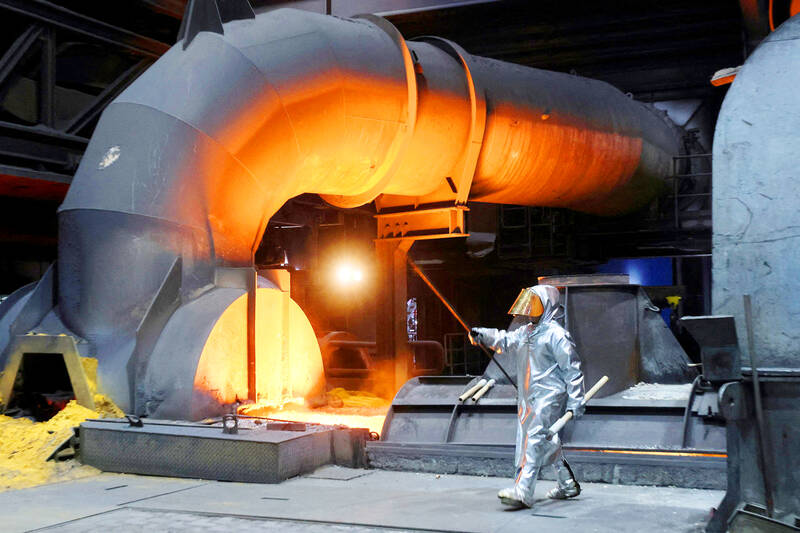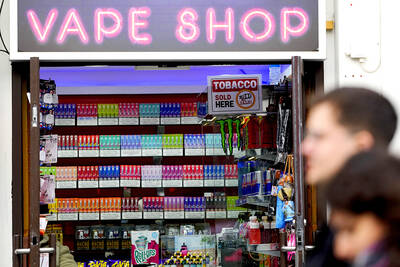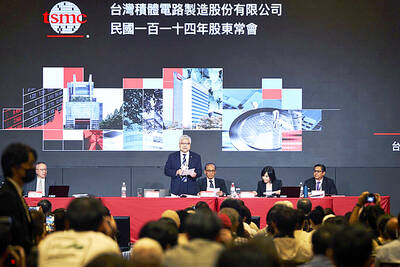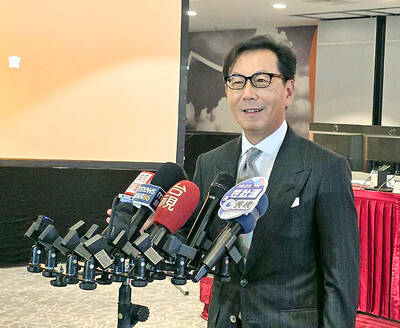The London Metal Exchange (LME) is entering the new year with the smallest available warehouse stockpiles in at least 25 years, setting the stage for future squeezes and spikes if demand turns out stronger than expected.
Available inventories of the six main metals traded on the LME plunged by two-thirds last year, with aluminum’s 72 percent decline accounting for the bulk of the drop, while zinc shrank by 90 percent.
Collectively, inventories not already marked for withdrawal hit the lowest level in data going back to 1997 on Thursday, and finished the year only fractionally higher.

Photo: REUTERS
While most of the world’s metal never sees the inside of an LME warehouse, exchange inventory levels are important because every short-seller who holds a contract to expiry must deliver physical metal registered in an LME warehouse.
The LME has introduced new rules to allow deferral to prevent future squeezes, but the exemptions come with costly fees.
The tight stockpiles also reflect a tension that has gripped metals markets for much of last year, between constrained supplies on the one hand, and worries about weakening demand due to recessionary threats in the world’s key economies on the other.
For traders on the LME, the dwindling inventories represent another in a litany of headaches following one of the most dramatic years in the exchange’s 145-year history. The LME is facing regulatory probes and lawsuits over its actions during a runaway short squeeze in the nickel market in March that pushed several LME dealers to the brink of default, and is due to soon publish the results of an independent review into the crisis.
Heading into this year, a key debate across metals markets was whether a worldwide downturn in industrial activity and rebounding supply would help replenish the industry’s threadbare reserves, while China’s rollback of COVID-19 curbs adds further uncertainty.
The debate over the outlook for metals supply and demand is particularly contentious in copper, where some analysts are predicting ongoing deficits, while others see the market swinging into a rare and historic period of oversupply.
That is feeding into a sharp divergence over the outlook for prices, with analysts at Goldman Sachs Group Inc predicting that copper would hit a record high of US$11,000 a tonne this year, while BNP Paribas said prices would drop to US$6,465 a tonne by the middle of the year as the market swings into a huge surplus.
Copper prices fell 0.5 percent to settle at US$8,372 at 5:51pm on the LME on Friday, capping the year with a 14 percent loss, the worst since 2018.
As the year drew to a close, only nickel was trading in positive territory. The market remained hamstrung by low liquidity since the crisis, with regular sharp swings.
The impact of the historic nickel squeeze has cooled trading activity in other metals as well, as investors grew concerned about a similar squeeze elsewhere.
As the LME waded through the fallout of last year’s nickel crisis, its US rival is gaining ground. Chicago-based CME Group Inc holds leading copper and precious-metals contracts, but has never managed to challenge the LME’s dominance in other industrial metals.
Last year, the US firm recorded strong growth in its aluminum contracts. Aggregate open interest in CME’s Comex aluminum futures contract was up more than 400 percent since the start of last year.
Aluminum and zinc on the LME had their worst year since 2018, with prices down 15 percent and 16 percent respectively. Tin was the worst performer — prices plunged by more than one-third and registered the biggest annual decline since at least 1990.

CAUTIOUS RECOVERY: While the manufacturing sector returned to growth amid the US-China trade truce, firms remain wary as uncertainty clouds the outlook, the CIER said The local manufacturing sector returned to expansion last month, as the official purchasing managers’ index (PMI) rose 2.1 points to 51.0, driven by a temporary easing in US-China trade tensions, the Chung-Hua Institution for Economic Research (CIER, 中華經濟研究院) said yesterday. The PMI gauges the health of the manufacturing industry, with readings above 50 indicating expansion and those below 50 signaling contraction. “Firms are not as pessimistic as they were in April, but they remain far from optimistic,” CIER president Lien Hsien-ming (連賢明) said at a news conference. The full impact of US tariff decisions is unlikely to become clear until later this month

Popular vape brands such as Geek Bar might get more expensive in the US — if you can find them at all. Shipments of vapes from China to the US ground to a near halt last month from a year ago, official data showed, hit by US President Donald Trump’s tariffs and a crackdown on unauthorized e-cigarettes in the world’s biggest market for smoking alternatives. That includes Geek Bar, a brand of flavored vapes that is not authorized to sell in the US, but which had been widely available due to porous import controls. One retailer, who asked not to be named, because

CHIP DUTIES: TSMC said it voiced its concerns to Washington about tariffs, telling the US commerce department that it wants ‘fair treatment’ to protect its competitiveness Taiwan Semiconductor Manufacturing Co (TSMC, 台積電) yesterday reiterated robust business prospects for this year as strong artificial intelligence (AI) chip demand from Nvidia Corp and other customers would absorb the impacts of US tariffs. “The impact of tariffs would be indirect, as the custom tax is the importers’ responsibility, not the exporters,” TSMC chairman and chief executive officer C.C. Wei (魏哲家) said at the chipmaker’s annual shareholders’ meeting in Hsinchu City. TSMC’s business could be affected if people become reluctant to buy electronics due to inflated prices, Wei said. In addition, the chipmaker has voiced its concern to the US Department of Commerce

STILL LOADED: Last year’s richest person, Quanta Computer Inc chairman Barry Lam, dropped to second place despite an 8 percent increase in his wealth to US$12.6 billion Staff writer, with CNA Daniel Tsai (蔡明忠) and Richard Tsai (蔡明興), the brothers who run Fubon Group (富邦集團), topped the Forbes list of Taiwan’s 50 richest people this year, released on Wednesday in New York. The magazine said that a stronger New Taiwan dollar pushed the combined wealth of Taiwan’s 50 richest people up 13 percent, from US$174 billion to US$197 billion, with 36 of the people on the list seeing their wealth increase. That came as Taiwan’s economy grew 4.6 percent last year, its fastest pace in three years, driven by the strong performance of the semiconductor industry, the magazine said. The Tsai